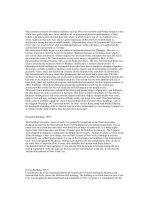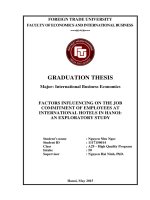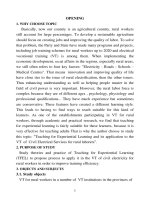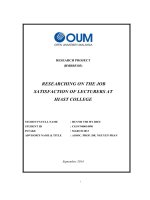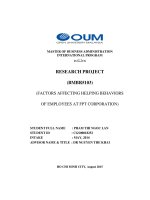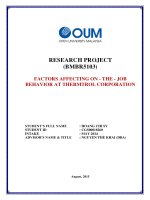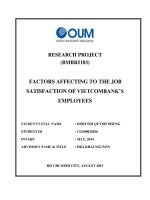Factors affecting to the job satisfaction of staffs at vinasoy corporation
Bạn đang xem bản rút gọn của tài liệu. Xem và tải ngay bản đầy đủ của tài liệu tại đây (549.85 KB, 47 trang )
RESEARCH PROJECT
(BMBR5103)
FACTORS AFFECTING TO THE JOB SATISFACTION OF
STAFFS AT VINASOY CORPORATION
STUDENT’S FULL NAME
STUDENT ID
INTAKE
: VO THI THANH THUY
: CGS00018263
: MAY 2014
ADVISOR’S NAME & TITLE : DR. NGUYEN THE KHAI (DBA)
Ho Chi Minh City, August 2015
1
Advisor’s assessment
………………………………………………………………………………………
………………………………………………………………………………………
………………………………………………………………………………………
………………………………………………………………………………………
………………………………………………………………………………………
………………………………………………………………………………………
………………………………………………………………………………………
………………………………………………………………………………………
………………………………………………………………………………………
………………………………………………………………………………………
………………………………………………………………………………………
………………………………………………………………………………………
………………………………………………………………………………………
………………………………………………………………………………………
________________
Advisor’s signature
2
ACKNOWLEDGEMENT
To complete this paper, I have to send my special thanks to Nguyen The Khai,
DBA who has shown our class every step of how to do a research and run SPSS
software.
Moreover, he had even personally gone through and give valuable
advised on our paper to every individual in class.
Without such detail instructions and advise, we are unable to complete this paper
of Business Research Methods.
I would also like to thanks employees of Vinasoy, whom had help to complete
the questionnaires which is essential for me to conduct further on the research.
Lastly, I would like to thanks my family for supporting me during my MBA
program and also my classmate whom have shared their knowledge and time to
learn together in order to complete all assignments especially this paper.
3
Contents
Abtract .........................................................................................................................7
Chapter1: INTRODUCTION Introduction of Vynasoy .......................................8
1.1
Introduction ...................................................................................................8
Main product of Vinasoy .........................................................................................8
Milestones: ...............................................................................................................8
Outstanding Achievement Vinasoy: .......................................................................9
1.2 Research Problem Statement ...........................................................................12
1.3 Purpose Of Research........................................................................................12
1.4 Scope Of Study ...............................................................................................13
1.5 Significance of Research ................................................................................13
1.6 Limitation Of Research...................................................................................13
Chapter 2 – LITERATURE REVIEW .................................................................15
2.1
Definition Of Con struct ..............................................................................15
2.1.1 Job Sactisfaction ........................................................................................15
2.1.2 Perceived Ability- Job fit ..........................................................................15
2.1.3 Supportive and non controlling suppervision ...........................................16
2.1.4 Pairness in skill- Based Pay ......................................................................18
2.1.5 Goal and Process clarity............................................................................20
2.2 Conceptual research Model .............................................................................24
2.3 Summary Of HyPotheses ................................................................................24
Chapter 3 – RESEARCH METHODOLOGY .....................................................24
3.1 Data Collection ................................................................................................25
3.2 Measure of Earch Construct ............................................................................25
3.2.1 Job Satisfaction..........................................................................................25
4
3.2.2 Perceived Ability- Job fit ..........................................................................26
3.2.3
Supportive and non controlling suppervision .......................................27
3.2.4 Pairness in skill- Based Pay.......................................................................28
3.2.5
Goal and Process clarity .......................................................................29
3. 3 Data Analysis ..................................................................................................30
Chapter 4 – RESEARCH FINDINGS AND ANALYSIS ....................................31
4.1
Data Analysi s ..............................................................................................31
4.2 Reliability Satistics ..........................................................................................31
4.3 Descriptive Statistics ......................................................................................33
4.4 Hypothesis Testing Result ..............................................................................34
Chapter 5 – DISCUSSION AND RECOMMENDATIONS ...............................36
5.1 Discussion ........................................................................................................36
5.2 Managerial Implication ...................................................................................37
5.3 Limitations And Recommendations For Fruture Research .............................37
Refeference ...............................................................................................................38
Appendix - Survey Questionnaire .............................................................................40
5
LIST OF TABLE
Table 1: Measurement of Job Satisfactio ..................................................................25
Table 2: Measurement of Perceived Ability- Job fit .................................................26
Table 3: Measurement of Supportive and non controlling suppervisionSupportive
supervision : ..............................................................................................................27
Table 4: Measurement of Pairness in skill- Based Pay .............................................29
Table 5: Measurement of Goal and Process clarity ..................................................30
Table 6: Cronbach's Alpha- Internal consistency .....................................................31
Table 7: Cronbach's Alpha of Construct Job Satisfaction ........................................32
Table 8: Cronbach's Alpha of Construct Perceived Ability- Job fit .........................32
Table 9: Cronbach's Alpha of Construct Supportive and non controlling
suppervision ..............................................................................................................32
Table 10: Cronbach's Alpha of Construct Pairness in skill- Based Pay ...................33
Table 11: Cronbach's Alpha of Goal and Process clarity .........................................33
Table 12: Descriptive Statistics .................................................................................33
6
Abtract
The objective of this study is to discuss the factors affecting job satisfaction of
employees in companies Vinasoy.
Analysis of this study whether or not there is a correlation between Perceived
Ability- Job fit, Supportive and non controlling suppervision, Pairness in skillBased Pay, Goal and Process clarity with Job satisfaction of employees, related to
the employee's leave job in the company. Data were collected through
questionnaires from staff of 5 departments.
This study focuses on the staff of Vinasoy and just focus on the job satisfaction
of employees. The results showed an improvement in assigning appropriate tasks,
strengthen the support of their superiors, Pairness in skill- Based Pay, Goal and
Process clarity to obtain satisfaction at work and commitment of staff working for
the company.
The results of this study have significant value for the Vinasoy‟s Human
Resources Department to improve their policies to retain talents.
Keywords: Job satisfaction,
Perceived Ability- Job fit, Supportive and non
controlling suppervision, Pairness in skill- Based Pay, Goal and Process clarity.
7
Chapter1: INTRODUCTION
Introduction of Vynasoy
1.1 Introduction
In 1997, VinaSoy establishment called dairy plant TX. In 2003, VinaSoy
change business strategy towards specializing in the manufacture and supply of
products processed from soybeans. On 16/05/2005, the company officially
renamed Vietnam soy milk and use the brand name is VinaSoy.
VinaSoy Company is one of the members of the General Quang Ngai Sugar
Joint Stock Company. Scope of Activities of VinaSoy is specialized in
manufacturing, supplying products of soy milk.
Main product of Vinasoy
- Soymilk Fami (box paper & paper bag).
- Black sesame soy milk VinaSoy (box paper).
Milestones:
The event marked "exit" is on Christmas day 2001, Fami soya milk products
are the United States Department of Agriculture selected as the exclusive
soymilk provides "school milk program in Vietnam ". The event is "a lifeline" to
the factory continued to operate and open the way forward.
I n 2003, dairy plants Changchun became the first Vietnam Enterprise
specializing in soymilk and pioneering products to enter the market as Fami soya
milk.
And dated 05.16.2005, brand personality Vinasoy with "natural, innovative,
dedicated" milk factory was born and officially changed Changchun Co. Soy
8
Milk Vietnam - VinaSoy. This is the first step on the road to becoming "a leader"
in Vietnam soya milk sector.
In 2008, an event that marked the development of the production line poured
VinaSoy TBA TBA 22 and 23 with a capacity of 20-24 thousand boxes / hour
(capacity of the largest series of Tetra Pak) makes a breakthrough capacity and
product quality.
In 2012 Vinasoy now complete building systems brand portfolio and brand
positioning. The biggest achievement is Vinasoy achieve Fami soya milk brand
has captured the feelings of consumers, and is currently leading the soy milk
market paper box with nearly 80% market share of the output.
Outstanding Achievement Vinasoy:
Since the transition to sustainable development phase to date, the Company
soymilk Vietnam has gradually asserted -Vinasoy reputation through product
quality standards and consumer trust. Typical prizes and certificates of merit
were awarded a row in the last 3 years as the golden imprint encouraging
collective companies increasingly have to make further efforts to deserve the
trust of consumers.
• 2015
• TOP 10 BEST BUSINESS GOODWILL VIETNAM
• HIGH QUALITY VIETNAM GOODS BY CONSUMERS POLLS
• BK POSITIVE CONTRIBUTION TO THE DEVELOPMENT OF HUMAN
RESOURCES VIETNAM
• 2014
• HIGH QUALITY VIETNAM GOODS BY CONSUMERS POLLS
• TOP 10 VIETNAM PRESTIGE BRANDS
9
• VIETNAM SERVICE PRODUCTS credit
• ETHICS GLOBAL ICONS
• TOP 20 "GOLDEN BRAND FOOD VIETNAM"
• 2013
• TOP 10 BRANDS ACHIEVE VinaSoy VIETNAM PRESTIGE 2013
• VinaSoy achieved title VIETNAM HIGH QUALITY PRODUCTS 2013
• Fami soya milk DAT HOT TOP 10 MARKS TIẾNG VIETNAM
• SOY MILK FOOD FAMI DAT SAFETY CERTIFICATION 2013
• SOY MILK FOOD VinaSoy DAT SAFETY CERTIFICATION 2013
• SOY MILK certified FAMI TOP 20 ASEAN KNOWN BRANDS OF 2013
• 2012
• Soy milk FAMI PRODUCTS ACHIEVE TOP 20 GOLDEN TIME
INTEGRATION
• CERTIFICATES TOP 100 NCC RELIABILITY
• FOOD SAFETY CERTIFICATION VinaSoy
• FOOD SAFETY CERTIFICATION FAMI
• VinaSoy achieved title VIETNAM HIGH QUALITY PRODUCTS 2012
• SOY MILK FAMI DAT AWARD FOR SUSTAINABLE BRANDS 100
2012
• 2011
• Fami soya milk DAT HOT TOP 50 MARKS TIẾNG VIETNAM
10
• MERIT TOP 20 SP-DV credit VIETNAM IN 2011
• VinaSoy achieved title VIETNAM HIGH QUALITY PRODUCTS 2011
VISION
"Becoming and is recognized as a leading company in the nutritional products
from soybeans in the market with business Vinasoy"
MISSION
"We are committed to continuous innovation and optimization of valuable
nutrients from natural soy to bring the community the opportunity to use popular
best quality products derived from soybeans. Thus, not only us, but our partners and
surrounding communities will have a more meaningful life, a better and more
prosperous "
CORE VALUES
- Blood Center: tireless efforts to bring these products optimal nutrition from
natural soy source to the consumer
- At the heart of cooperation: mounted with partners to deliver a better life, more
meaningful & Prosperity
- Clean & ethics: honest behavior and ethical in all activities and transactions
- Innovation: always at the forefront of research and advanced scientific
applications in soy processing technology in order to give birth to the strong brand
and reputation
- Spiritual Vietnam: proud to be a Vietnamese brand, is inherited good value
"solidarity", "drinking water source memory" of Vietnam
11
1.2 Research Problem Statement
Human resources are a valuable asset of Vinasoy. Therefore, developing and
maintaining talent is very important for the organization because it is one of the
factors that will have a major impact on the success of the business of the company.
In recent years, state officials - the staff, especially the young staff, capable,
resigned tends to increase. That makes the company leadership very worried.
With high employee turnover, the company not only lost skilled labor and their
experience but also bear many costs of recruitment and training of staff.
Although no formal basis but company executives also somewhat aware that
there is dissatisfaction on the job for several groups of people who have stopped
working .. therefore urgent issue now is to find out the level of satisfaction of the
staff and workers are working in Vinasoy to know which employees have job
satisfaction or not, these factors make employees satisfied. That is the reason for
choosing the theme: "Research on the job satisfaction of employees in Vinasoy"
1.3 Purpose Of Research
The purpose of this study was to examine the relationship between original
Perceived Job Ability- fit, Supportive and non controlling suppervision, print
Pairness skill- Based Pay, Goal and Process clarity related to the satisfaction of
employees in companies Vinasoy .
Hopefully with the findings of the study could provide experimental evidence in
the aspect of factors affecting job satisfaction of employees in the company, which
may provide some measures relating to raising the level of employee satisfaction at
Vinasoy.
12
With the results of research, management and HR department of Vinasoy can
mean valuable to improve their policies to enhance job satisfaction of employees in
the company.
1.4 Scope Of Study
This study was conducted on all 350 employees of Vinasoy office blocks,
including Sales & Marketing, Division of Administrative Management, Finance and
Accounting and Technology Division produced. Each employee is sent with a
questionnaire to fill out.
1.5 Significance of Research
This study was conducted to have an understanding of the factors that affect job
satisfaction in the organization. In order for the management of the company to
have a clearer view on issues that affect the employees' retirement coa more
capacity. This study can also serve as a reference for other managers to improve the
working environment and conditions for their parts.
With these findings, the management of the company may revise policies and set
out a strategy to retain their staff by creating an environment, policies and better
working conditions.
Research model as a basis, as well as references to related studies and other
research.
1.6 Limitation Of Research
This study has some limitations. First, the focus of this study are employees of
Vinasoy, so findings can not be generalized for employees of all enterprises
operating in Vietnam.
13
Second, the survey has been conducted in a short time. A total of 350
questionnaires were distributed to the employees in five departments of the
company, only 289 responses were returned of which 270 can be used. The
remaining 28 questions that most of the questions blank and can not be used for
further study.
Future studies should explore the relationship between job satisfaction and
business performance of the company, which is a limitation of this study.
14
Chapter 2 – LITERATURE REVIEW
2.1 Definition Of Con struct
2.1.1 Job Sactisfaction
Vroom (1964) defined that employee satisfaction is a state that employees have a
clear mandate to work in the organization. At the same time, gave the determining
factor for satisfaction: salary, bonus, working conditions, job task identified.
vangevich and Matteson (1999), satisfaction at work is the attitude of people
about their work, it is the result of accepting the job and the most appropriate level
between individuals and organizations.
Frederick Herzberg (1959) shows two groups of factors relating to satisfaction.
Two elements of this theory is: The element maintained as working conditions,
wages, mode ... the motivating factor: as the recognition, promotion
Weiss et al. (1967), gave the criteria for measuring job satisfaction through
Minnesota questionnaire (MSQ), in which the question of the ability to use their
abilities, achievements, progress evaluation rights, corporate policy, co-workers, the
supervision of their superiors.
Studies by Smith, Kendal and Hulin (1969) has developed indicators job
description (JDI) to assess the level of satisfaction the work of a staffed with 5
factors: job characteristics, superior , salaries, opportunities for training and
advancement, and colleagues.
2.1.2 Perceived Ability- Job fit
Definition
Ability-job fit can be defined as the "fit between the abilities of a person and the
demands of a job, or the desires of a person and the attributes of a job" (Sekiguchi,
2004).
Ability- Job fit and Job Satisfaction
15
The ability job-fit model demonstrates that work performance, personal
satisfaction and outcomes are enhanced when the employee and work environment
are in perfect synch. Synchronization is a process that includes not just education
and experience, but many dimensions of individual's abilities: ability to learn,
mental hard-wiring, personality archetypes, leadership dynamics and physical
abilities (Coppola, Carini, 2006).
The review of the ability-job fit literature by Edwards (1991) recognized job
satisfaction, low job stress, motivation, performance, attendance and retention as
outcomes that are positively affected by ability-job fit. When ability-job fit is
assessed as the match between what an employee wants and receives from
performing job, it is linked to enhance job-satisfaction, integration, and
organizational commitment, as well as reduced intentions to resign. Additional
benefits for task performance have been established when the meaning of abilityjob fit is expanded to include the match between abilities and their job demands.
Therefore, the hypotheses below can be proposed.
H1: There is a positive relationship between Ability- Job fit and Job
Satisfaction
2.1.3 Supportive and non controlling suppervision
Definition
A study done by Stahl and Koser (1978) indicated that R&D scientists‟ creativity
was significantly related to their supervisors‟ supportive attitude.
Supportive and non controlling suppervision and Job Satisfaction
A study done by Ceci and Iubatti (2011) searches answers to the question if
personal relationships play a role in supporting innovative activities. The results
conclude that the coexistence of personal and professional relationships shape a
unique context that changes the usual dynamics of innovation diffusion (Ceci and
Iubatti, 2011) .
Oldham and Cummings (1996) examined three characteristics of the
organizational context-job complexity, supportive supervision, and controlling
16
supervision-to three indicators of employee‟s creative performance: patent
disclosures written, contributions to an organization suggestion program, and
supervisory ratings of creativity. Results showed that employees were most creative
in their work when they had appropriate creativity relevant characteristics, worked
on complex, challenging jobs, and were supervised in a supportive and noncontrolling organizational environment (Oldham and Cummings, 1996) .
The organizational context in which an individual performs a task influences his
or her intrinsic motivation, which in turn affects creative achievement (Amabile,
1988) .The existing literature fails to include the organizational component of trust
in leader as a part of the leader‟s supporting and non-controlling attitude which
might increase the creativity of the employees in the work place. Existing literature
in general supports that supervisory attitude that is supportive of the employees is
expected to enhance creative achievement and on the other hand, supervisory
attitude which is controlling is expected to diminish creative performance (Deci,
Connell, Ryan, 1989) .
For the purposes of our research we propose that non - controlling supervision
creates a work climate based on trust which make the employees express
themselves more confidently and creatively since they will know that their
supervisors will show respect and concern for their feelings and opinions and let
them express themselves more creatively.
Supportive and non controlling suppervision and Job Satisfaction
When supervisors are supportive, they show concern for employees‟ feelings
and needs; encourage them to voice their own concerns; provide positive, chiefly
informational feedback; and facilitate employee skill development (Deci, Connel,
&Ryan, 1989) . When supervisors are controlling, they closely monitor employee
behavior; make decisions without employee employement; provide feedback in a
controlling manner, and generally pressure employees to think, feel or behave in
prescribed ways (Oldham and Cummings, 1996)
When the supervisor is behaving in a supportive attitude and does not show a
17
controlling behavior employees feel free to express themselves more innovatively.
Finding new ways of doing one‟s work, letting creativity into work life requires a
supportive environment. Non-controlling behavior and trust in one‟s supervisor are
climatic components of open communication cultures (Demirel and Fikes, 2010;
Butchoz, 1993) .In such an environment employees feel free to express themselves
in different contexts. Interest in work innovation or “finding new ways of doing
one‟s job” is not an investigated area since its first introduction to the field (Price,
1972) . Finding new ways of doing your job ends up in more satisfied employees
and increased performance.
This relationship can be the subject of a future study. Also finding out the other
necessary conditions in the business organization improving the creativity and
initiative taking capabilities of the employees where especially necessary in sectors
which seek after „innovation can be the subject of a future study. In this study we
observed that when the supervisors behaving in a supportive attitude and does not
show a controlling attitude employees feel free to express themselves more
innovatively.
Therefore, the hypotheses below can be proposed.
H2: There is a positive relationship between Supportive and non controlling
suppervision and Job Satisfaction.
2.1.4 Pairness in skill- Based Pay
Definition
Pay is an important job attribute (Jurgensen, 1978) and greater job satisfaction
results, inter alia, from job rewards (Rusbult and Farrell, 1983; Anderson, Jerman
and Constantin, 1979).
A skill based pay system (SBPS) can best be described as 'a system in which the
capabilities of individuals are the primary focus and which cause them to be
managed in a way that facilitates organizations developing organizational
capabilities that provide competitive advantage' (Lawler III, p6, 1993). Simply put,
employees are paid in accordance with the number of positions they are able to
18
fulfill in an organization.
Pairness in skill- Based Pay and Job Satisfaction
The main reason for adopting a skill based approach is to create a competitive
advantage (Lawler , 1993; Murray and Gerhart, 1998) even though the training
costs and hourly wages are higher (Tosi and Tosi, 1986). Furthermore it would aid
in attracting new employees and retaining existing ones. However, academics
argue that, for the skill based system to work
effectively, certain organizational elements have to be met. For instance, Lawler
(1986) found that the system works best in a high involvement environment. In
addition, Gomez-Mejia and Balkin (1992) suggested that the following elements
benefited the results of a SBPS: the organization is situated in a start up or growth
phase, has a participative culture and offers other incentive programs
complementing skill based pay.
Murray and Gerhart (1998) suggest that a relevant theory to describe a SBPS is
the expectancy theory. Here, skill seeking and acquisition is motivated by
rewarding an employee for skill or knowledge competencies. In terms of the model
of Vroom (1964)7, the incremental pay increases are the reward outcome, the
value of the increase is the valence, the exertion of skill competency is the effort
outcome and the level of skill seeking behavior is the input effort (Murray and
Gerhart, 1998). This is in accordance with Tosi and Tosi (1986) who state that
workers in a skill based pay system have strong incentives to increase knowledge
and skill since higher skill l Although a skill based pay system (SBPS) is in most
cases beneficial for the firm, it is expected that employees will still prefer a job
based pay system. Not only is it hard to determine how 'competent' one is, the
employee also has to invest in additional education/training in order to receive a
decent salary. The myopic loss aversion theory states that employees are generally
risk averse and have a short evaluation horizon (Bernartzi and Thaler,1995;
Bowman, Minehart and Rabin, 1999; Van der Sar, 2008). Uncertainty about the
exact demands, additional investments in learning and the fear of falling behind are
19
all elements that make a SBPS more risk bearing. Tosi and Tosi (1986) report that
especially workers with low motivation, ability and tolerance for work ambiguity
will be unsatisfied with a SBPS.evels are associated with both higher status and
with pay
Employees will perceive a higher level of satisfaction and motivation from a job
based pay system than from a skill based pay system. - Pairness in skill- Based
Pay make employees feel more satisfied
Therefore, the hypotheses below can be proposed.
H3: There is a positive relationship between Pairness in skill- Based Pay
and Job Satisfaction
2.1.5 Goal and Process clarity
Definition
In general terms, the process of setting goals helps you choose where you want
to go. By knowing precisely what you want to achieve directionally, you know
where you have to concentrate your efforts and hopefully you will also quickly
spot the distractions that would otherwise lure you from your course.
Goal a Organizational goal ambiguity has been defined as the “degree to which
goals allow [for] interpretive leeway, or leeway in how one interprets, conceives,
and applies the goals” (Chun and Rainey 2005a; Feldman 1989, 5-7). When goals
allow for less interpretive leeway, they are more certain and clear (i.e., goal clarity);
conversely, when goals allow for greater leeway, they are characterized as being
more ambiguous (i.e., goal ambiguity). Although ambiguous goals provide certain
advantages to organizations and organizational leaders (e.g., the ability to [re- ]cast
issues or political demands in ways that advance or safeguard organizational
interests), existing research tends to focus on the employee-related effects of goal
ambiguity (see Radin 2006 for a discussion of the benefits of ambiguous goals;
To be able to even begin the journey of working towards a goal, we first need to
ensure that we have complete clarity. Goal clarity can be simply described as your
ability to set a clear and specific objective that all affected parties understand and
20
can work towards achieving. The important part of this definition is the word
“specific.” A very broad or general goal won‟t help drive you or anyone else to
succeed. If your goal is simply to “shape up,” that is not a well-defined goal. It
may be broadly accurate but is not helpful to describe what actually has to be done
and to give others a clear guide as to what is expected.
Goal and Process clarity and Job Sactisfaction
All goals need to be clear, concise and action-oriented and be expressed in such
a way that there can be little doubt about the specific outcome that is being sought.
Unfortunately, we are less likely to consistently set such specific goals. People
generally tend to stick to the safe and secure status quo and often fail to either get
out of their comfort zone or convert loose language into meaningful actioncentered words. In others words, people can be lazy and express goals in vague and
ambiguous ways and think that they have told people what they need.
Clear goals signal what an organization values and expects from workers, while
concomitantly specifying how employee action relates to individual rewards and the
organization‟s broader mission (Stazyk et al. 2011, 610; Wright 2004; Locke and
Latham 1990, 2002; Milkovich and Wigdor 1991).
In fact, the clarity of an organization‟s goals and expectations can lend
considerable credence to organizational systems, such as pay-for-performance, in
the eyes of employees (Milkovich and Wigdor 1991). Not only do clear goals help
set expectations for employees, but research also indicates goal clarity serves an
important motivational purpose in organizations. When organizations set goals that
are specific, challenging but attainable, viewed as legitimate by employees, and
supported by managers, employees demonstrate higher levels of motivation and
performance (see e.g., Locke and Latham 1990, 2002; Wright 2004). In part,
motivation and performance gains result from the overarching tendency and desire
of employees‟ to work toward organizational goals to begin with (e.g., because they
find meaning in the organization‟s mission, because of a desire to master tasks, or
for extrinsic reasons such as increased pay) (Locke and Latham 1990, 2002).
21
However, as described above, clear goals also bring a sense of purpose and
direction to an employee‟s job (Stazyk et al. 2011; Barnard 1938; Wright 2001,
2004; Wilson 1989). Unfortunately, when employees are subject to vague or
inconsistent goals, they frequently find it more difficult to understand their
individual roles within an organization, as well as how their work-related tasks
connect to an organization‟s broader mission and objectives (Stazyk et al. 2011;
Rizzo, House, and Lirtzman 1970; House and Rizzo 1972; Chun and Rainey 2005a,
2005b; Pandey and Rainey 2006).
As a result, workers may struggle to link their actions to an organization‟s
mission. 9 When employees fail to understand an organization‟s mission and goals
or their own unique roles within the organization, several negative individual and
organizational outcomes are likely to occur. For instance, research indicates these
employees exhibit higher levels of occupational stress and anxiety, job absence, and
turnover, as well as lower levels of physical and emotional health and
organizational commitment (see e.g., Rizzo et al. 1970; House and Rizzo 1972;
Stazyk et al. 2011).
Most notably, goal ambiguity also translates into lower levels of employee job
satisfaction (e.g., Chun and Rainey 2005a, 2005b; Wright 2001, 2004; Wright and
Davis 2003). Employee job satisfaction has been defined as a “pleasurable or
positive emotional state resulting from the appraisal of one‟s job…” (Locke 1976,
1300). Job satisfaction, itself, has direct (and indirect) bearing on important
individual and organizational outcomes, including employee work motivation,
turnover, productivity, and commitment (see e.g., Mobley et al. 1979; Mobley,
Homer, and Hollingsworth 1978; Locke 1976; Wright 2001, 2004; Wright and
Davis 2003).
Mobley and colleagues (1979) argue, for example, job satisfaction is the single
best predictor of employee turnover, which itself imposes considerable costs on
organizations (see also, Moynihan and Pandey 2008; Llorens and Stazyk 2011).
Turnover costs include direct losses in productivity as well as indirect declines due
22
to recruitment and training expenses and losses in institutional knowledge and
memory (Mobley et al. 1979; Staw 1980; Balfour and Neff 1993; Moynihan and
Pandey 2008;
Llorens and Stazyk 2011). Because of its apparent influence on job satisfaction,
work motivation, and individual and organizational productivity, public
administration scholars argue research exploring the factors that lead to increased
goal clarity (or, conversely, diminished goal ambiguity) and employee goal
commitment are desperately needed in the field (see e.g., Wright 2001, 2004; Chun
and Rainey 10 2005a, 2005b; Pandey and Rainey 2006; Stazyk and Goerdel 2011;
Jung 2012). Wright (2001) maintains any effort to sort out the influence of goals on
employee job satisfaction and work motivation necessitates a firmer understanding
of an employee‟s work context, job characteristics, and job attitudes. These factors,
he believes, provide considerable insight into the overall structure and content of
organizational goals, as well as the likelihood employees will demonstrate goal
commitment. A complete test of Wright‟s model is beyond the scope of this paper.
However, and consistent with other goal ambiguity research, Wright maintains goal
conflict leads to greater goal ambiguity and, consequently, reductions in job
satisfaction (and work motivation). Diversity management scholarship frequently
acknowledges the fact that increased workforce diversity introduces conflict into
organizations (e.g., Pitts 2005; Wise and Tschirhart 2000; Foldy 2004). Conflict
may be interpersonal or may arise from miscommunication among organizational
members. However, as new and different perspectives are introduced into an
organization, conflict is also likely to reflect legitimate disputes over the domains
and content of organizational goals and action (e.g., Foldy 2004; Choi and Rainey
2010; Pitts 2005; Page 2007; Langbein and Stazyk 2011). Consequently, as
organizations become more diverse, goal conflict and ambiguity are likely to
increase as well. 2 Consistent with past research, higher levels of goal ambiguity
often translate into lower levels of employee job satisfaction, which has important
implications for individual and organization performance and productivity.
Therefore, the hypotheses below can be proposed.
23
H3: There is a positive relationship between Goal and Process clarity and
Job Satisfaction
2.2 Conceptual research Model
Following is the conceptual research model:
Perceived Ability- Job fit
H1+
Supportive and non controlling
suppervision
H2+
H3+
Pairness in skill- Based Pay
Job Satisfaction
H4+
Goal and Process clarity
Figure 1 : Conceptual Research Model
2.3 Summary Of HyPotheses
My model suggests that Perceived Ability- Job fit, Supportive and non
controlling suppervision , Pairness in skill- Based Pay and Goal and Process clarity
are factors influencing Job Satisfaction, summarized in the hypotheses listed below:
Hypotheses 1: Perceived Ability- Job fit is positively related to Job
Satisfaction.
Hypotheses 2: Supportive and non controlling suppervision is
positively related to Job Satisfaction
Hypotheses 3: Pairness in skill- Based Pay is positively related to Job
Satisfaction
Hypotheses 4: Goal and Process clarity is positively related to Job
Satisfaction
Chapter 3 – RESEARCH METHODOLOGY
24
3.1 Data Collection
Participants of the survey are employees of Vynasoy in 5 departments. The
questionnaires were sent out by email to all 350 employees for printing out and fill
in. 289 responses were returned in which only 270 were usable. Making the overall
response rate at around 77 per cent. The data analyses used in this research are
based on the survey results of these 270 respondents. Timing of this survey is from
May 2015 to August 2015.
3.2 Measure of Earch Construct
3.2.1 Job Satisfaction
This meaasure was developed by Schriesheim and Tsui (1980). It uses six items
to form and index that describes overall job sactisfaction . The scale includes single
question to assess the degree of sactisfaction with the work ifself, supervion, coworker, pay, promotion opportunities, and the job in general.
The questions used the a 5-point Likert-type scale where 1 = strongly disagree
and 5 = strongly agree.
Following table 1 shows the measurement Job Satisfaction of by Schriesheim
and Tsui (1980
Table 1: Measurement of Job Satisfaction
No
1
Item
Measurement
How satisfied are you with the nature of the work
you perform?
2
How satisfied are you with the person who
supervises you superior?
3
5-point
Likert-type
scale
How satisfied are you with your relations with others
in the organization with whom you work?
25
